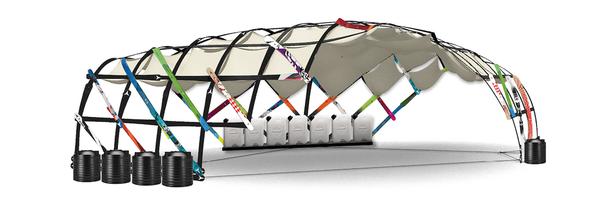Building a nomad pavilion out of old skis

© 2017 EPFL Jan Brütting
Could recovered materials play a key role in tomorrow’s civil engineering? EPFL researchers set out to answer that question by creating an easily demountable pavilion out of more than 200 reclaimed skis.
Is there a middle road between producing new materials and recycling them? You bet – reusing them! Researchers at the smart living lab in Fribourg came up with a slightly off-the-wall project based on the idea that the stuff we throw away could be the makings of sustainable construction. Guided by this concept, the researchers collected hundreds of old skis, whose mechanical properties proved ideal for building a collapsible pavilion.
"In the construction industry, talk about sustainable building usually revolves around insulation, energy efficiency, materials, recycling and biodegradation,” says Corentin Fivet, who heads EPFL’s Structural Xploration Laboratory (SXL). “But recycling is expensive and biodegradation is not always a feasible option. Another way to avoid producing new materials and use less energy is to repurpose materials as they are."
We need more research on the topic before ensuring its feasibility. But it could, for example, be paired with other existing building methods. Two examples are prefabrication and nomad architecture which uses support structures that can be repeatedly assembled and disassembled. “In our lab, we’re focusing on the support structures used for buildings because conventional structures – between their foundations and roofs – account for most of the eventual waste.”
Elastic gridshell
After some trial and error with various materials – fishing rods came up short in terms of their mechanical properties and supply – they settled on skis. Like many other types of sports equipment, skis are technological wonders. Fivet says: “Skis typically bring together extensive technical refinements and, even if they’ve outlived their original purpose, should be reused.”
One aspect of the project was to determine the structural potential of skis for their new purpose. They had to be flexible in one direction and rigid in the other. They also had to be able to withstand applied loads and perform consistently over time.
“We tested all types of skis – downhill, slalom, cross-country and freeride – and placed them at strategic points of the pavilion depending on their properties,” says Sofia Colabella, another researcher on the project. “Skis, which are made from high-tech materials, turned out to be almost better than wood, which is more commonly used in this type of structure.”
Colabella specializes in elastic gridshells, which are as flexible as metallic netting but become as stiff as a shell when fastened in place. The trick lies in arranging the individual components in two directions, so that they become a very flexible grid of rectangles. The grid is first built flat on the ground, and then the edges of the grid are pulled in. Because the individual modules are flexible, the center of the grid consequently arches upward. Once the structure has obtained its final shape, it is held in place by attaching other components diagonally in certain spots. This makes it stable and stiff. This structure can be used to cover a large area with small components, and it doesn’t require complicated tools or a formwork.

Headed for Lyon this summer
The researchers’ nomad pavilion is made out of 210 skis and held in place by 300 bolts – less than a hundred of which are needed for the reassembly. This project was selected for the Biennale Architecture Lyon, where it will be on display starting this June. The researchers hope to be able to set up their pavilion in different, popular areas of the city over the course of the event.
“Our goal isn’t to make buildings out of skis. It’s to show that we can use uncontrolled and uncontrollable materials with a sufficient level of confidence in the structure’s safety and performance. It’s an exercise, a manifesto, that shows there are some interesting things to be done in this relatively unexplored field,” says Fivet.
Corentin Fivet (project investigator), Sofia Colabella (gridshell designer and worksite manager), Bernardino D'Amico (engineering consultant), Claude-Alain Jacot (construction), Jan Brütting (construction), Valeria Didonna (construction), Endrit Hoxha (Life-cycle analysis)















